
A book is a medium for recording information in the form of writing or images, typically composed of many pages bound together and protected by a cover. The technical term for this physical arrangement is codex. In the history of hand-held physical supports for extended written compositions or records, the codex replaces its predecessor, the scroll. A single sheet in a codex is a leaf and each side of a leaf is a page.
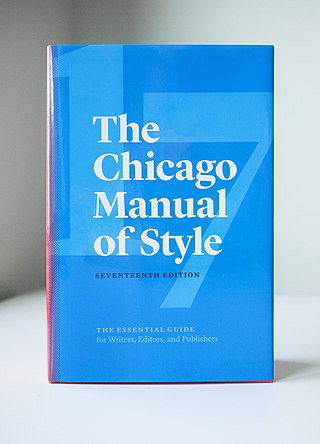
The Chicago Manual of Style is a style guide for American English published since 1906 by the University of Chicago Press. Its 17 editions have prescribed writing and citation styles widely used in publishing. It is "one of the most widely used and respected style guides in the United States". The guide specifically focuses on American English and deals with aspects of editorial practice, including grammar and usage, as well as document preparation and formatting. It is available in print as a hardcover book, and by subscription as a searchable website as The Chicago Manual of Style Online. The online version provides some free resources, primarily aimed at teachers, students, and libraries.
The West American Digest System is a system of identifying points of law from reported cases and organizing them by topic and key number. The system was developed by West Publishing to organize the entire body of American law. This extensive taxonomy makes the process of doing case law legal research less time consuming as it directs the researcher to cases that are similar to the legal issue under consideration.
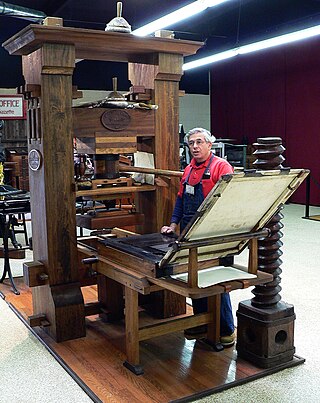
To publish is to make content available to the general public. While specific use of the term may vary among countries, it is usually applied to text, images, or other audio-visual content, including paper. The word publication means the act of publishing, and also any printed copies issued for public distribution.
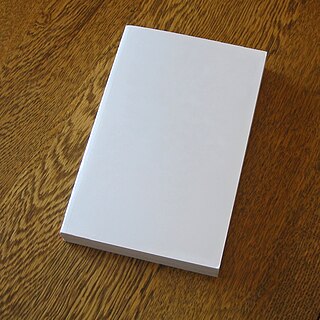
A paperback book is one with a thick paper or paperboard cover, and often held together with glue rather than stitches or staples. In contrast, hardcover (hardback) books are bound with cardboard covered with cloth, leather, paper, or plastic.

A hardcover, hard cover, or hardback book is one bound with rigid protective covers. It has a flexible, sewn spine which allows the book to lie flat on a surface when opened. Modern hardcovers may have the pages glued onto the spine in much the same way as paperbacks. Following the ISBN sequence numbers, books of this type may be identified by the abbreviation Hbk.
The bibliographical definition of an edition includes all copies of a book printed from substantially the same setting of type, including all minor typographical variants.
Legal deposit is a legal requirement that a person or group submit copies of their publications to a repository, usually a library. The number of copies required varies from country to country. Typically, the national library is the primary repository of these copies. In some countries there is also a legal deposit requirement placed on the government, and it is required to send copies of documents to publicly accessible libraries.
An ashcan comic is a form of the American comic book originally created solely to establish trademarks on potential titles and not intended for sale. The practice was common in the 1930s and 1940s when the comic book industry was in its infancy, but was phased out after updates to US trademark law. The term was revived in the 1980s by Bob Burden, who applied it to prototypes of his self-published comic book. Since the 1990s, the term has been used to describe promotional materials produced in large print runs and made available for mass consumption. In the film and television industries, the term 'ashcan copy' has been adopted for low-grade material created to preserve a claim to licensed property rights.

The Legal Deposit Libraries Act 2003 is an Act of the Parliament of the United Kingdom which regulates the legal deposit of publications in the United Kingdom. The bill for this Act was a private member's bill. This Act was passed to update the legislation on legal deposit to reflect the digital age.

Book design is the art of incorporating the content, style, format, design, and sequence of the various components and elements of a book into a coherent unit. In the words of renowned typographer Jan Tschichold (1902–1974), book design, "though largely forgotten today, [relies upon] methods and rules upon which it is impossible to improve, [and which] have been developed over centuries. To produce perfect books, these rules have to be brought back to life and applied". Richard Hendel describes book design as "an arcane subject", and refers to the need for a context to understand what that means.
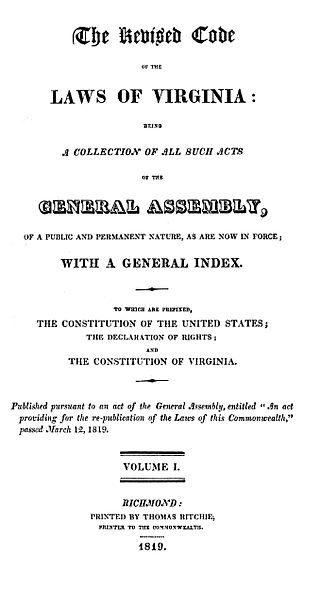
The Code of Virginia is the statutory law of the U.S. state of Virginia, and consists of the codified legislation of the Virginia General Assembly. The 1950 Code of Virginia is the revision currently in force. The previous official versions were the Codes of 1819, 1849, 1887, and 1919, though other compilations had been printed privately as early as 1733, and other editions have been issued that were not designated full revisions of the code.
The New Hampshire Revised Statutes Annotated (RSA) forms the codified law of the state subordinate to the New Hampshire State Constitution.

Armed Services Editions (ASEs) were small paperback books of fiction and nonfiction that were distributed in the American military during World War II. From 1943 to 1947, some 122 million copies of more than 1,300 ASE titles were distributed to servicemembers, with whom they were enormously popular. The ASEs were edited and printed by the Council on Books in Wartime (CBW), an American non-profit organization, in order to provide entertainment to soldiers serving overseas, while also educating them about political, historical, and military issues. The slogan of the CBW was: "Books are weapons in the war of ideas."
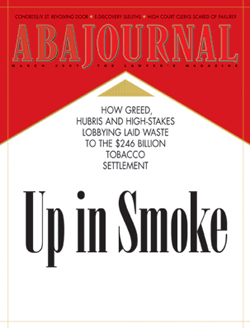
The ABA Journal is a monthly legal trade magazine and the flagship publication of the American Bar Association. It is now complemented online by a full-featured website, abajournal.com and its various e-newsletters and apps.

Bookbinding is the process of physically assembling a book of codex format from an ordered stack of signatures, sheets of paper folded together into sections that are bound, along one edge, with a thick needle and strong thread. Cheaper, but less permanent, methods for binding books include loose-leaf rings, individual screw-posts, twin loop spine coils, plastic spiral coils, and plastic spine combs. For protection, the bound stack of signatures is wrapped in a flexible cover or is attached to stiffened boards. Finally, an attractive cover is placed onto the boards, which includes the publisher's information, and artistic decorations.

An ebook, also known as an e-book or eBook, is a book publication made available in digital form, consisting of text, images, or both, readable on the flat-panel display of computers or other electronic devices. Although sometimes defined as "an electronic version of a printed book", some e-books exist without a printed equivalent. E-books can be read on dedicated e-reader devices, but also on any computer device that features a controllable viewing screen, including desktop computers, laptops, tablets and smartphones.

The following outline is provided as an overview of and topical guide to books:

The Balme Library, established in 1948 is located on the main campus of the University of Ghana. The Balme Library was named after David Mowbray Balme, the first Principal of the University of Ghana. The Balme Library is the main library of the University of Ghana and is also the largest within the University of Ghana Library System (UGLS). It is endowed with information resources, IT infrastructure and expert staff. Since its establishment in 1948, the library has gone through successive growth with its printed book collection totaling over 400,000 volumes. The library subscribes to an increasing number of online databases including electronic journals (e-journals) and electronic books (e-books).
A manuscript is the work that an author submits to a publisher, editor, or producer for publication. In publishing, "manuscript" can also refer to one or both of the following:













